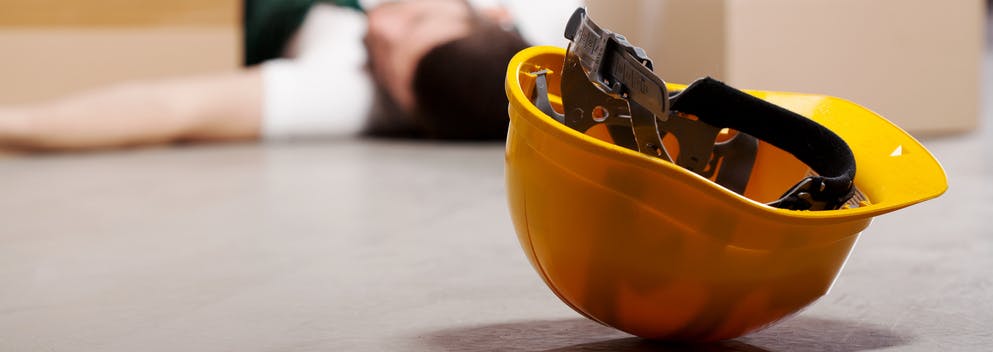Working in the construction industry is one of the most dangerous jobs in the United States. According to OSHA, one of every five work-related deaths occurs in the construction industry, and an unknown number of construction workers are seriously injured in accidents each year.
Workers spend their days improving infrastructure and building new structures on dangerous construction sites. While some of their responsibilities are simple, others are potentially hazardous. For most construction workers, working on elevated ground and operating heavy equipment is a daily event, and access to electricity increases the risk of damage. Minor injuries such as bruises, lacerations, a dislocated shoulder, or a broken bone can occur in construction accidents. Regretfully, many construction accidents result in death.
OSHA issued four fatal causes of death and injury accidents on the construction site, called Fatal Four. Falls, struck by an object, electrocutions, and caught in or between are the fatal four. In 2017, falls were the prime cause of death, and almost 5,147 labors lost their lives. In 2018, according to the Bureau of Labor, there were 1,008 construction accidents, among them 320 accidents related to falling hazards and were deadly. Employers and workers can assist with the number of work-related casualties each year by knowing the dangers of these incidents and the safety steps implement to overcome them.
FALLS:
It is the most common factor of accidents in the workplace, and penalty of fall injuries can control if address before. Falls hazards also happen when employees do not take safety measures. Do work on unprotected roof edges, use faulty ladders, and work on imbalanced scaffolding are also the reasons for falls. Falling from a roof is the most common source of accidents on construction projects. These types of construction accidents can reduce with safety training and fall avoidance measures.
To prevent falls, OSHA regulations on construction fall protection standards are available at 29 CFR 1926 subpart M which provides many options to an employer. OSHA also encourages to adopt as much as fall protection system at the workplace. These are the most highlighted areas where fall incident happens.
- Unprotected sides and edges:
Employees should protect from fall from exposed sides and corners of horizontal and vertical walking/working areas (horizontal and vertical surfaces) six feet or higher above lower levels. You can use one of three types of traditional fall safety systems.
- Guardrail systems
- Safety net systems
- Personal fall arrest systems
- Overhand bricklaying and related work
Many of you possibly monitor overhand bricklaying daily. OSHA guideline provides you to safeguard workers from the dangers of their jobs in different ways, including.
- Guardrail systems
- Personal fall arrest systems
- Safety net systems
- Controlled access zones.
- Roof work on low-slope roofs
Protect employees work on low-slope roofs with unprotected sides and edges six feet or more above lower levels. Your options are:
- Guardrail systems
- Safety net systems
- Personal fall arrest systems
- A combination of
- Warning line and guardrail systems
- Warning line and safety net systems
- Warning line and personal fall arrest systems, or safety monitoring systems (on roofs 50 feet or less in width).
- Holes
Employees in various industries are exposed to holes regularly. Employees can be wounded or killed if they step into holes, trip over holes, fall through holes, or are hit by objects falling through those holes, especially during construction work.
Employees on walking/working surfaces must safeguard from falling into or through holes (including skylight openings) six feet or more above lower levels by the following measures.
- Installing a cover over the hole
- Erecting a guardrail system around the holes
- The use of a personal fall arrest system
Three main things require the attention of an employer before starting any project. Plan out the entire project, how to complete the work, the cost of the whole project, risk factors, the safety of employees. And how much time and tools are needed to complete the project.
Providing the right equipment is also a significant task. If workers are working above six feet, they should receive proper safety gear and harnesses to avoid fall injuries.
Training of employees, each employee should know the use of the equipment and establish an understanding regarding the fall hazards. In their training workers, need to learn the proper way of reporting any fall protection issue.
STRUCK BY AN OBJECT:
The second most common factor of accidents at the workplace is employees struck by an object, includes vehicles, machines like cranes or lifters, and falling objects. Almost 8% of injuries at the workplace are associated with being struck by an object.
Flying and falling objects, such as tools, construction materials, and garbage, can also cause injury and harm the employee in the most disastrous way. Several safety hazards can cause and contribute to these types of injuries ranging from failure to provide hardhats to failing to place proper guards on saws and other pieces of equipment.
To reduce the chances of being struck by an object, employees wear High-visibility clothing, encouraging awareness of the hazard and instructing workers to never place themselves between moving objects.
ELECTROCUTIONS:
Electrocution is the third major cause of construction site accidents. Electrocutions can occur due to insufficient lockout and tag-out processes, faulty wiring and electrical components, or faulty electrical system design.
Construction workers frequently operate near live wires and powerful electrical currents. Burns, shocks, fires, and explosions are all possible outcomes of electrical dangers in the construction industry. While any of these mishaps can be fatal, one of OSHA Fatal Four is electrocution, which happens when a worker exposes to a lethal amount of electrical energy. If a worker charges with lifting an aluminum ladder and comes into contact with overhead electricity lines, this could happen. Contact with electrical sources, such as broken or naked wires, and improper extension and flexible cables are electrocution hazards in construction.
CAUGHT IN OR BETWEEN:
Being caught-in or compressed by equipment or objects, and struck, caught, or crushed in falling structure, equipment, or material is rank fourth on OSHA's list of the Fatal Four. Being pinned by reversing cars and being injured by products falling from forklifts and delivery trucks are examples of these types of mishaps.
Trench or excavation collapses, rolling, sliding, moving objects, and stuck in machinery are examples of these accidents. Crushing injuries are common in these accidents. Workers may be in danger when they focus on the task at hand. Workers should never get in the way of big machinery or any other immovable object. Caught in the middle mishaps can be avoided through constant monitoring, attentiveness, and reinforcement of safety standards.



